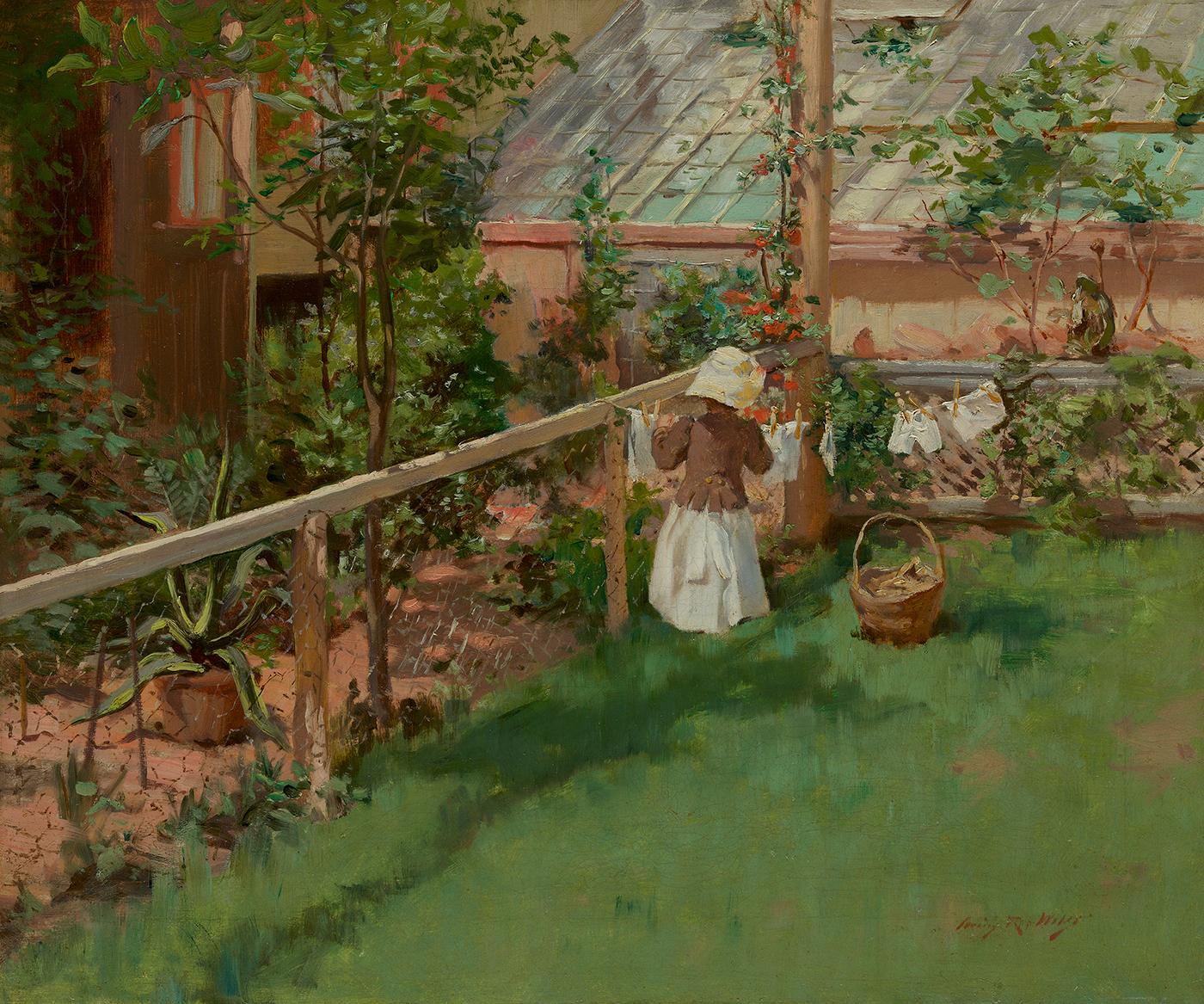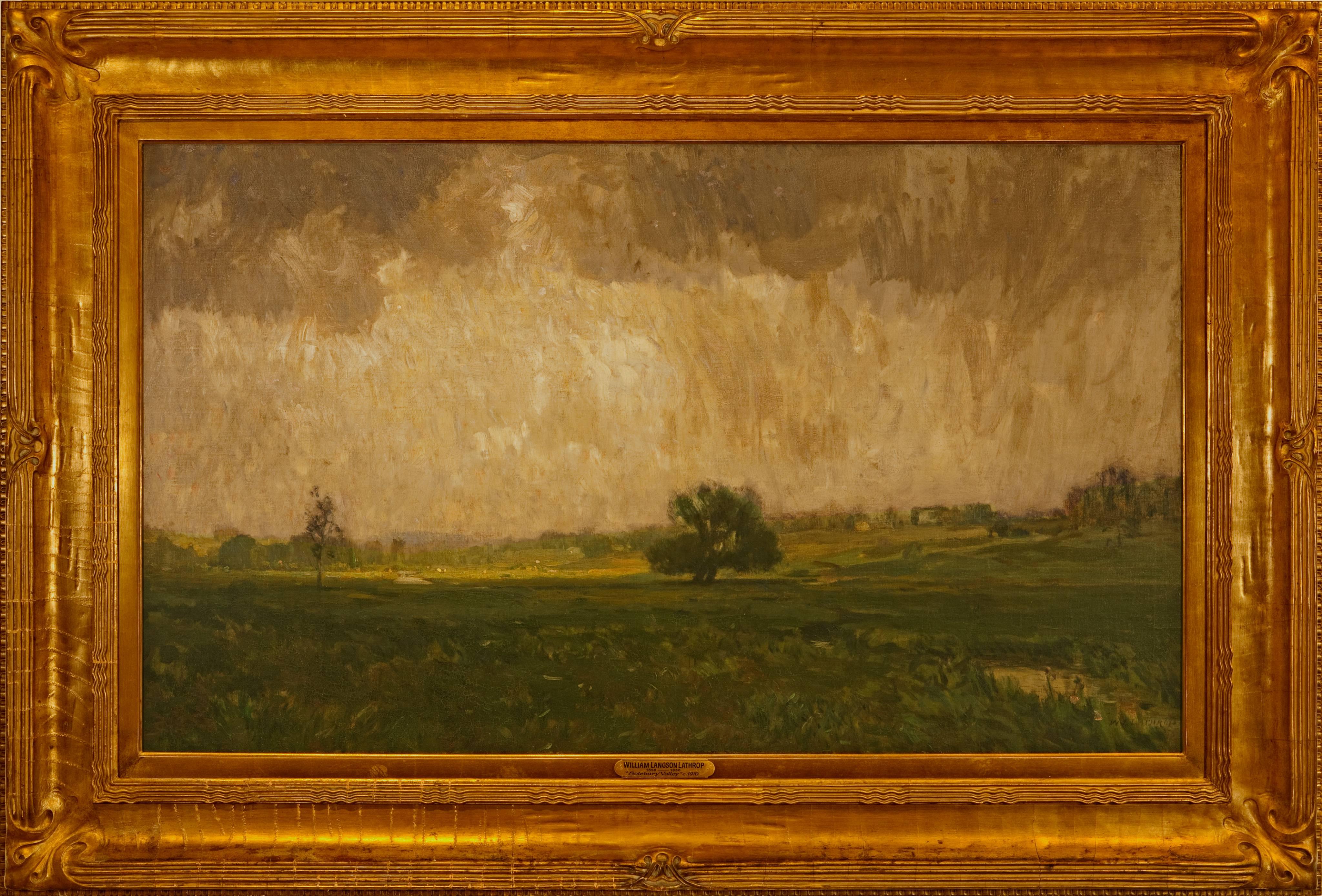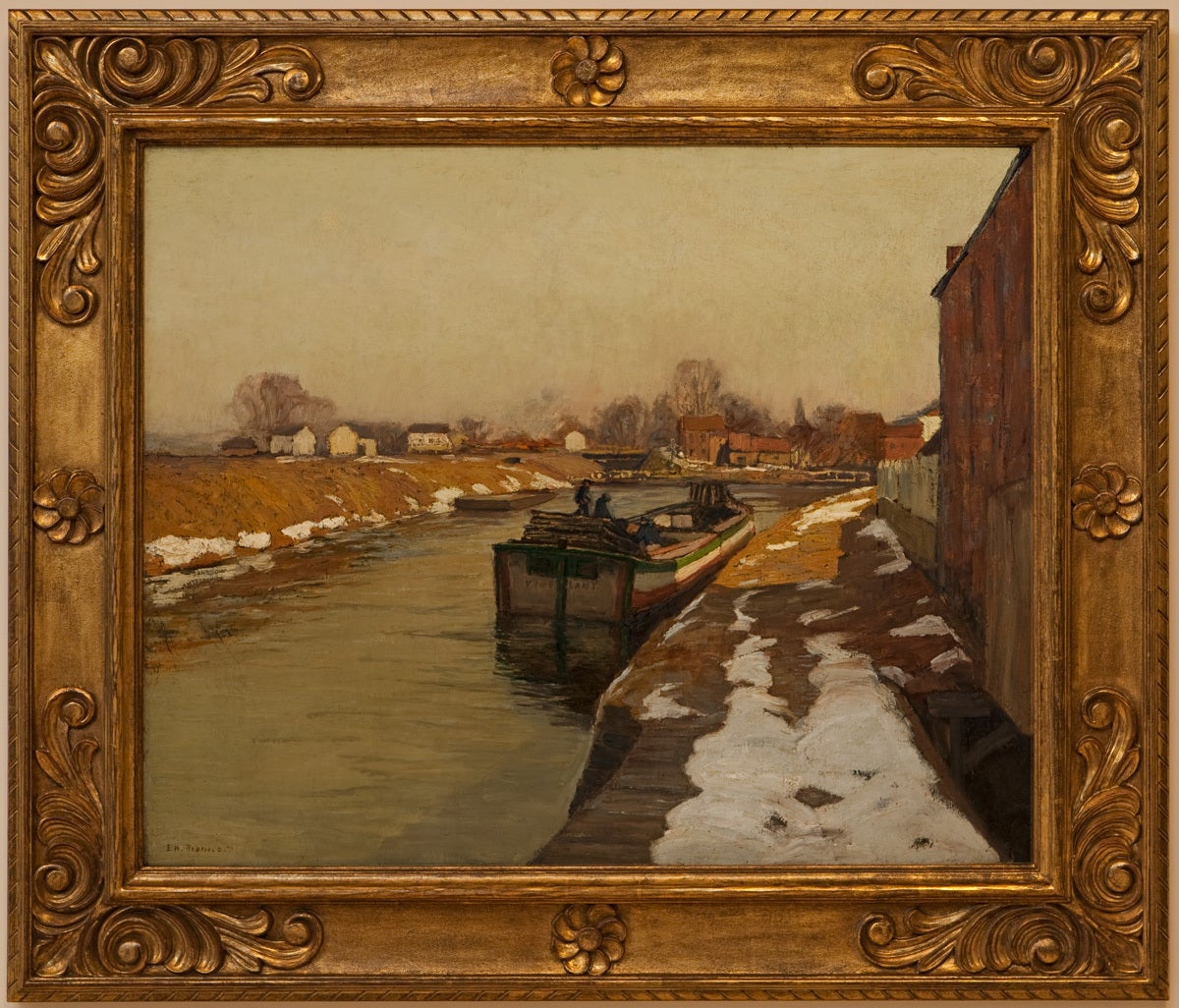Want more images or videos?
Request additional images or videos from the seller
Guy WigginsNew York Harbor
About the Item
Signed lower right.
Guy Carleton Wiggins adopted the bright palette and lively brushwork of the impressionist movement, and is best known for his New York City snow scenes and landscapes in the area of the Impressionist colony of Old Lyme, Connecticut.
The son of artist John Carleton Wiggins, Guy Wiggins was born and grew up in Lyme where his parents had purchased a country house and studio. Beginning 1917, both father and son gave their addresses as Old Lyme, which by then was an unofficial artist colony, dating from 1903 when Childe Hassam began painting there.
Wiggins spent part of his childhood in England and on the Continent where his father, landscape artist John Carleton Wiggins, took his family during the 1890s. Back in America, Guy entered the Polytechnic Institute in Brooklyn to study architecture. Soon he decided to become a painter and transferred to the National Academy of Design, beginning a life-long affiliation with that institution.
Wiggins studied with noted artists of the Old Lyme Colony who were developing their own style of impressionism - combining the French traditions and emerging American technique. He may have begun to paint his signature winter scenes after an unsuccessful attempt to paint a sunny landscape in his New York studio in winter.
His combination of the bright colors of urban life with flickering snowfall and the city's massive architecture (aided perhaps by some earlier training he had had in architecture) proved extremely successful. His New York cityscape painting, Metropolitan Tower, purchased by the Metropolitan Museum of Art in 1912, supposedly made Wiggins the youngest American artist to have work enter that museum's permanent collection. "In the painting, the tower dominates the middle distance, but it is seen through an atmospheric haze created by the winter weather and by smoke coming from the numerous buildings that surround it." (Pfeil).
He won prizes from the Connecticut Academy of Fine Arts, the Salmagundi Club and the Art Club of Philadelphia, and in 1917, he won the prestigious Harris Bronze medal from the Art Institute of Chicago
Wiggins set up his canvas in a variety of geographical locations including Long Island and the Bay of Fundy in Canada as well as around New England.
In 1937, Wiggins established his own art school in the nearby town of Essex. Wiggins was a painterly Realist who worked on a wide variety of subjects: robust and well-loved scenes of New York City in the snow or in the spring sunshine, still-life, delicate flower compositions and the street-scenes and landscapes of foreign lands. Cartier regularly reproduces his New York winter scenes for its "Holiday Card Collection".
Some other critics have felt that his repeated application of a similar approach to snow scenes in various locales of New York became somewhat repetitive in contrast to the spontaneity of his Old Lyme summer landscapes.
Both his New York snow scenes and delicate New England scenes are valued by collectors. Wiggins had an exhibition of his works in Richmond in 1921, painting "Washington Square in Winter" specifically for this exhibition. The painting was subsequently purchased by the museum, and the Richmond Art Museum's archives contain original correspondence with the artist.
He had many one-man and group shows throughout the east and is listed in Who's Who in American Art and Who's Who in the East. He was a member of the National Arts Club and the Salmagundi Club, both in New York. Wiggins' work is included in many collections and two of his paintings hang in the White House.
- Creator:Guy Wiggins (1883 - 1962, American)
- Dimensions:Height: 23.5 in (59.69 cm)Width: 44.5 in (113.03 cm)Depth: 4 in (10.16 cm)
- Medium:
- Movement & Style:
- Period:
- Condition:
- Gallery Location:Saratoga Springs, NY
- Reference Number:1stDibs: LU17025822061
About the Seller
4.2
Vetted Seller
These experienced sellers undergo a comprehensive evaluation by our team of in-house experts.
Established in 1992
1stDibs seller since 2015
30 sales on 1stDibs
Typical response time: 19 hours
- ShippingRetrieving quote...Ships From: Saratoga Springs, NY
- Return PolicyA return for this item may be initiated within 3 days of delivery.
More From This SellerView All
- The Red House, Cornwall, ConnecticutBy Charles Warren EatonLocated in Saratoga Springs, NYSigned lower left. Born in Albany, New York, Charles Eaton became a Tonalist landscape painter much influenced by George Inness. His intimate, moody landscapes were known for subdued golden-brown hues and muted tonal harmonies, and the subject was often the landscape in late autumn, evening time, or winter. These paintings were groundbreaking because they were relatively small in scale and intimate countryside views, which was a departure from the generally popular panoramic, romanticized views of Hudson River School painters. In 1879, he enrolled at the National Academy of Design in New York City and then studied figure painting at the Art Students League with J. Carroll Beckwith. He became a close associate with Leonard Ochtman and Ben Foster...Category
Mid-20th Century American Impressionist Landscape Paintings
MaterialsOil, Canvas
- Wall Street New YorkBy Gail Sherman CorbettLocated in Saratoga Springs, NYSigned lower right.Category
Mid-20th Century American Impressionist Figurative Paintings
MaterialsOil, Canvas
- High Bridge, New YorkBy Arthur Clifton GoodwinLocated in Saratoga Springs, NYSigned lower right. Bio: A painter especially known for street and waterfront scenes of Boston, Arthur Clifton Goodwin did work that captured the subtle nuances of light and color, ...Category
Early 20th Century American Impressionist Landscape Paintings
MaterialsOil, Canvas
- Autumn LandscapeBy William Merritt PostLocated in Saratoga Springs, NYSigned lower left. "Scholars continually rediscover competent American artists who enjoyed successful careers at the turn of the century, but whose legacy has been lost over time. One of these, William Merritt Post, was a tonalist landscape painter often associated with the Barbizon school and the early New England Impressionists...Category
Early 20th Century American Impressionist Landscape Paintings
MaterialsOil, Board
- Gramacy Army Plaza Brooklyn NYBy Johann Berthelsen, 1883-1972Located in Saratoga Springs, NYSigned lower right. Following his graduation, he toured the United States and Canada as lead baritone for the Grand Opera Company, after which he taught voice - first as his alma matter...Category
Mid-20th Century American Impressionist Landscape Paintings
MaterialsOil, Board
- Mango Trees, Rio Piedras, Puerto RicoBy Reynolds BealLocated in Saratoga Springs, NYSigned lower left and dated 1921. About the artist: From an affluent and artistic family, Reynolds Beal and his younger brother Gifford both made careers in art. Beal was born in ...Category
1920s Impressionist Landscape Paintings
MaterialsOil, Canvas
You May Also Like
- At the ClotheslineBy Irving Ramsey WilesLocated in New York, NYSigned lower right: Irving R. WilesCategory
Late 19th Century American Impressionist Landscape Paintings
MaterialsCanvas, Oil
- "Alley Fiends"By John R. GrabachLocated in Lambertville, NJJim’s of Lambertville is proud to offer this artwork by: John R. Grabach (1886 - 1981) John Grabach was a highly regarded New Jersey artist, teacher, and author of the classic text...Category
1930s American Impressionist Landscape Paintings
MaterialsCanvas, Oil
- "Forest Strongholds"By John F. CarlsonLocated in Lambertville, NJSigned lower right. Complemented by a hand carved and gilt frame. Exhibited at the National Academy of Design, 1928Category
20th Century American Impressionist Landscape Paintings
MaterialsCanvas, Oil
- "Solebury Valley"By William Langson LathropLocated in Lambertville, NJSigned lower right. Complemented by a period frame. William L. Lathrop (1859-1938) Deemed “Father of the New Hope Art Colony”, William Langson Lathrop was born in Warren, Illinois. He was largely self-taught, having only studied briefly with William Merritt Chase in 1887, at the Art Students League. Lathrop first moved east in the early 1880s, and took a job at the Photoengraving Company in New York City. While there, he befriended a fellow employee, Henry B. Snell. The two men became lifelong friends and ultimately, both would be considered central figures among the New Hope Art Colony. Lathrop's early years as an artist were ones of continuing struggle. His efforts to break through in the New York art scene seemed futile, so he scraped enough money together to travel to Europe with Henry Snell in1888. There he met and married an English girl, Annie Burt. Upon returning to New York, he tried his hand at etching, making tools from old saw blades...Category
1910s American Impressionist Landscape Paintings
MaterialsCanvas, Oil
- Winter MoonlightBy George William SotterLocated in Lambertville, NJsigned lower rightCategory
1910s American Impressionist Landscape Paintings
MaterialsCanvas, Oil
- "The Canal"By Edward Willis RedfieldLocated in Lambertville, NJJim’s of Lambertville is proud to offer this artwork. Signed lower left. Complemented by a hand carved and gilt frame. Illustrated in "Edward Redfield: Just Values and Fine Seeing" by Constance Kimmerle and the Pennsylvania Academy of the Fine Arts's Exhibition of Paintings by Edward Redfield (April 17 to May 16, 1909) brochure Edward Willis Redfield (1869 - 1965) Edward W. Redfield was born in Bridgeville, Delaware, moving to Philadelphia as a young child. Determined to be an artist from an early age, he studied at the Spring Garden Institute and the Franklin Institute before entering the Pennsylvania Academy from 1887 to 1889, where he studied under Thomas Anshutz, James Kelly, and Thomas Hovenden. Along with his friend and fellow artist, Robert Henri, he traveled abroad in 1889 and studied at the Academie Julian in Paris under William Bouguereau and Tony Robert-Fleury. While in France, Redfield met Elise Deligant, the daughter of an innkeeper, and married in London in 1893. Upon his return to the United States, Redfield and his wife settled in Glenside, Pennsylvania. He remained there until 1898, at which time he moved his family to Center Bridge, a town several miles north of New Hope along the Delaware River. Redfield painted prolifically in the 1890s but it was not until the beginning of the twentieth century that he would develop the bold impressionist style that defined his career. As Redfield’s international reputation spread, many young artists gravitated to New Hope as he was a great inspiration and an iconic role model. Edward Redfield remained in Center Bridge throughout his long life, fathering his six children there. Around 1905 and 1906, Redfield’s style was coming into its own, employing thick vigorous brush strokes tightly woven and layered with a multitude of colors. These large plein-air canvases define the essence of Pennsylvania Impressionism. By 1907, Redfield had perfected his craft and, from this point forward, was creating some of his finest work. Redfield would once again return to France where he painted a small but important body of work between 1907 and 1908. While there, he received an Honorable Mention from the Paris Salon for one of these canvases. In 1910 he was awarded a Gold Medal at the prestigious Buenos Aires Exposition and at the Panama-Pacific Exposition of 1915 in San Francisco, an entire gallery was dedicated for twenty-one of his paintings. Since Redfield painted for Exhibition with the intent to win medals, his best effort often went into his larger paintings. Although he also painted many fine smaller pictures, virtually all of his works were of major award-winning canvas sizes of 38x50 or 50x56 inches. If one were to assign a period of Redfield’s work that was representative of his “best period”, it would have to be from 1907 to 1925. Although he was capable of creating masterpieces though the late 1940s, his style fully matured by 1907 and most work from then through the early twenties was of consistently high quality. In the later 1920s and through the 1930s and 1940s, he was like most other great artists, creating some paintings that were superb examples and others that were of more ordinary quality. Redfield earned an international reputation at a young age, known for accurately recording nature with his canvases and painting virtually all of his work outdoors; Redfield was one of a rare breed. He was regarded as the pioneer of impressionist winter landscape painting in America, having few if any equals. Redfield spent summers in Maine, first at Boothbay Harbor and beginning in the 1920s, on Monhegan Island. There he painted colorful marine and coastal scenes as well as the island’s landscape and fishing shacks. He remained active painting and making Windsor style furniture...Category
Early 1900s American Impressionist Landscape Paintings
MaterialsCanvas, Oil
Recently Viewed
View AllMore Ways To Browse
New York Mid Century
New York Seen
New York City Mid Century
Old Vintage New York
Old New England
Vintage Card Collection
Father And Son Vintage
Cartier New York
Cartier In New York
Vintage Art Guy
Retro Winter Scene
New York City Snow
Mid Century Urban Landscapes
New England Winter
Winter In New England
Harbor House
Guy Manning
New England Snow





